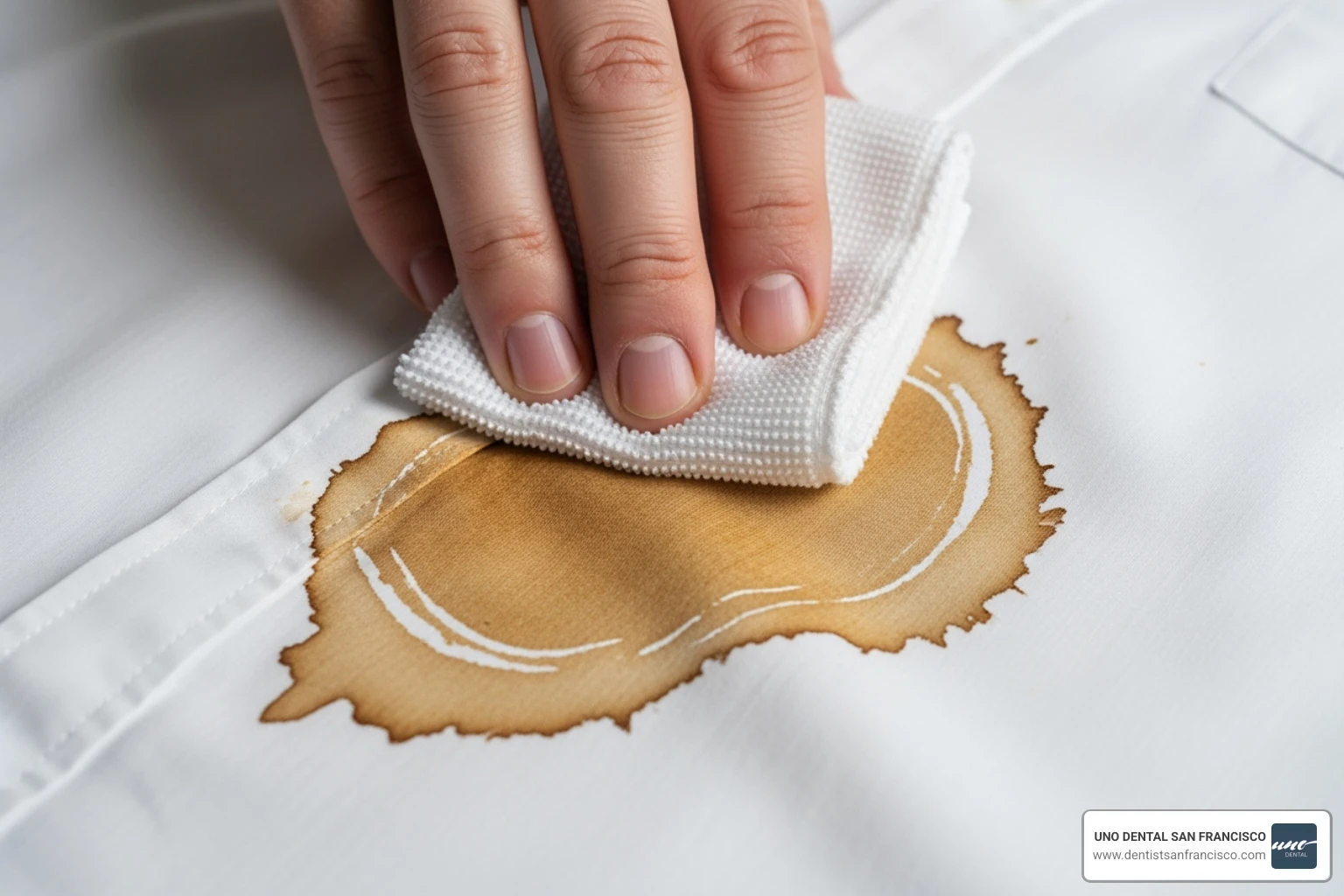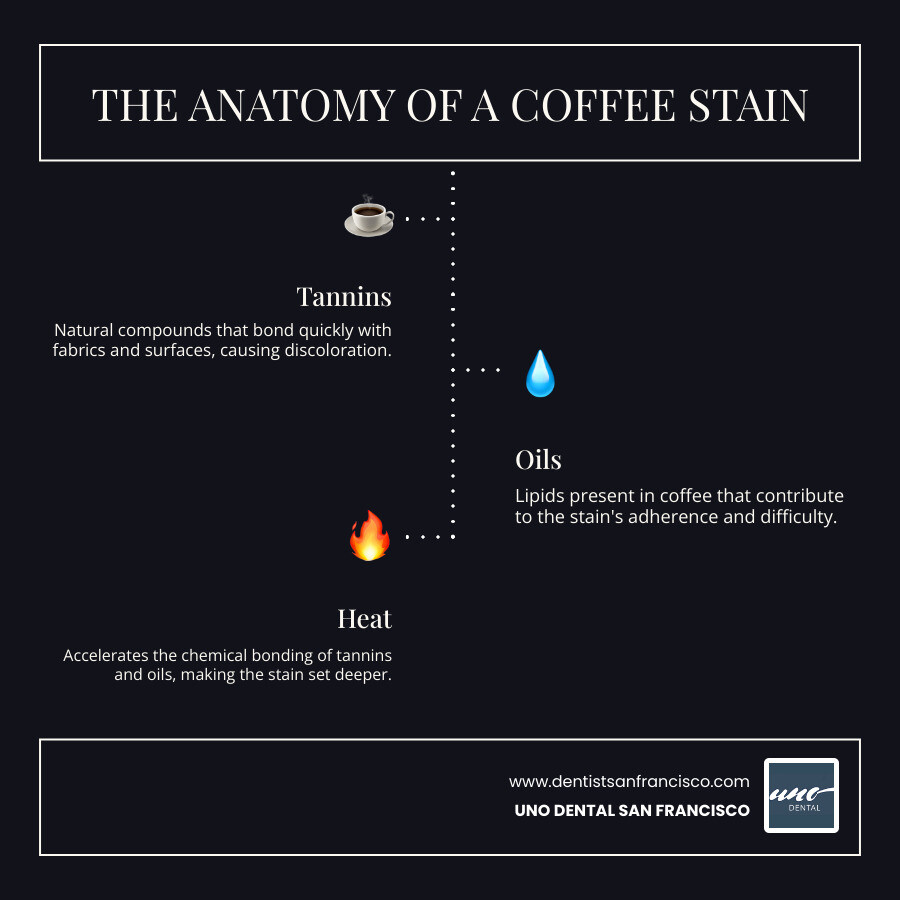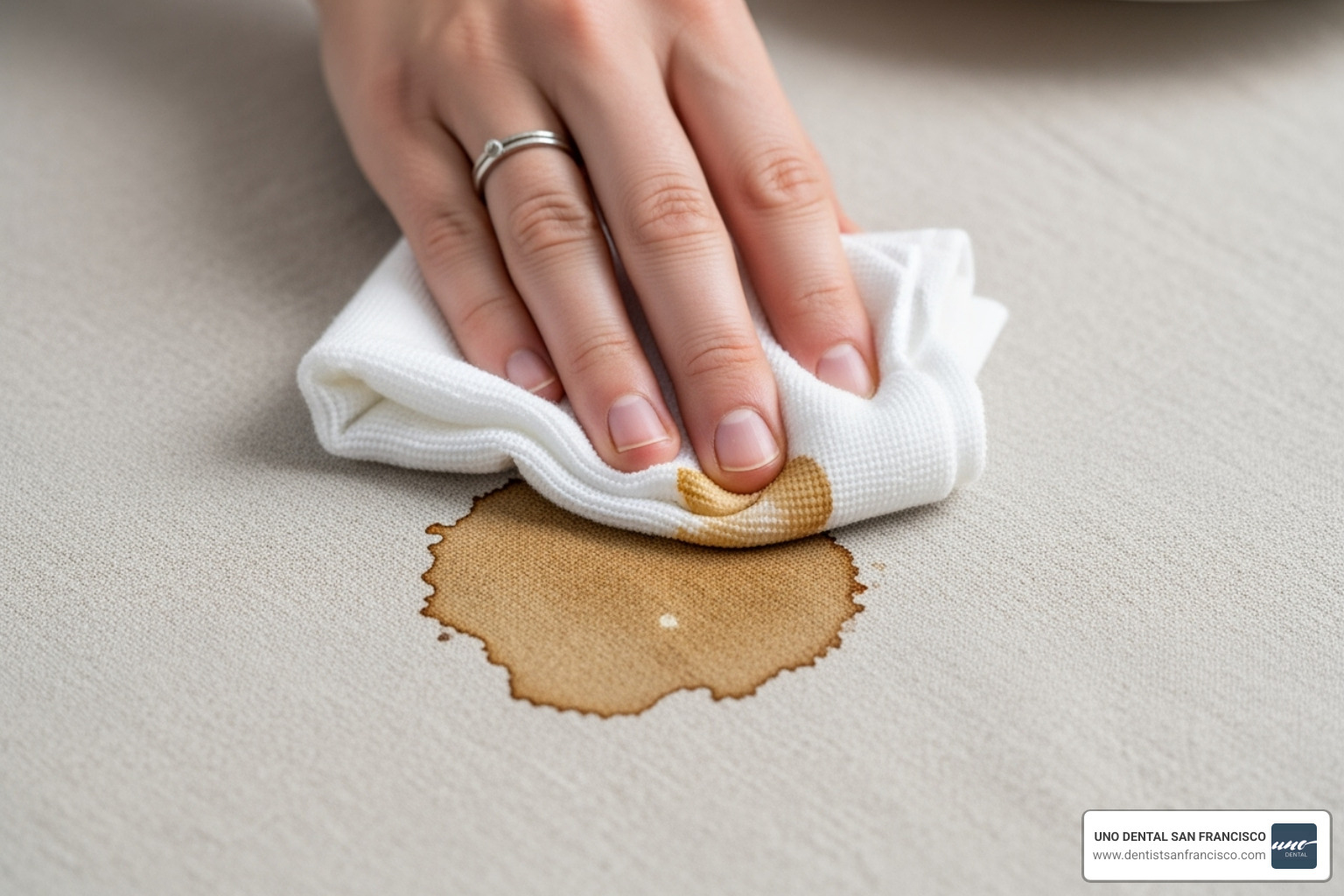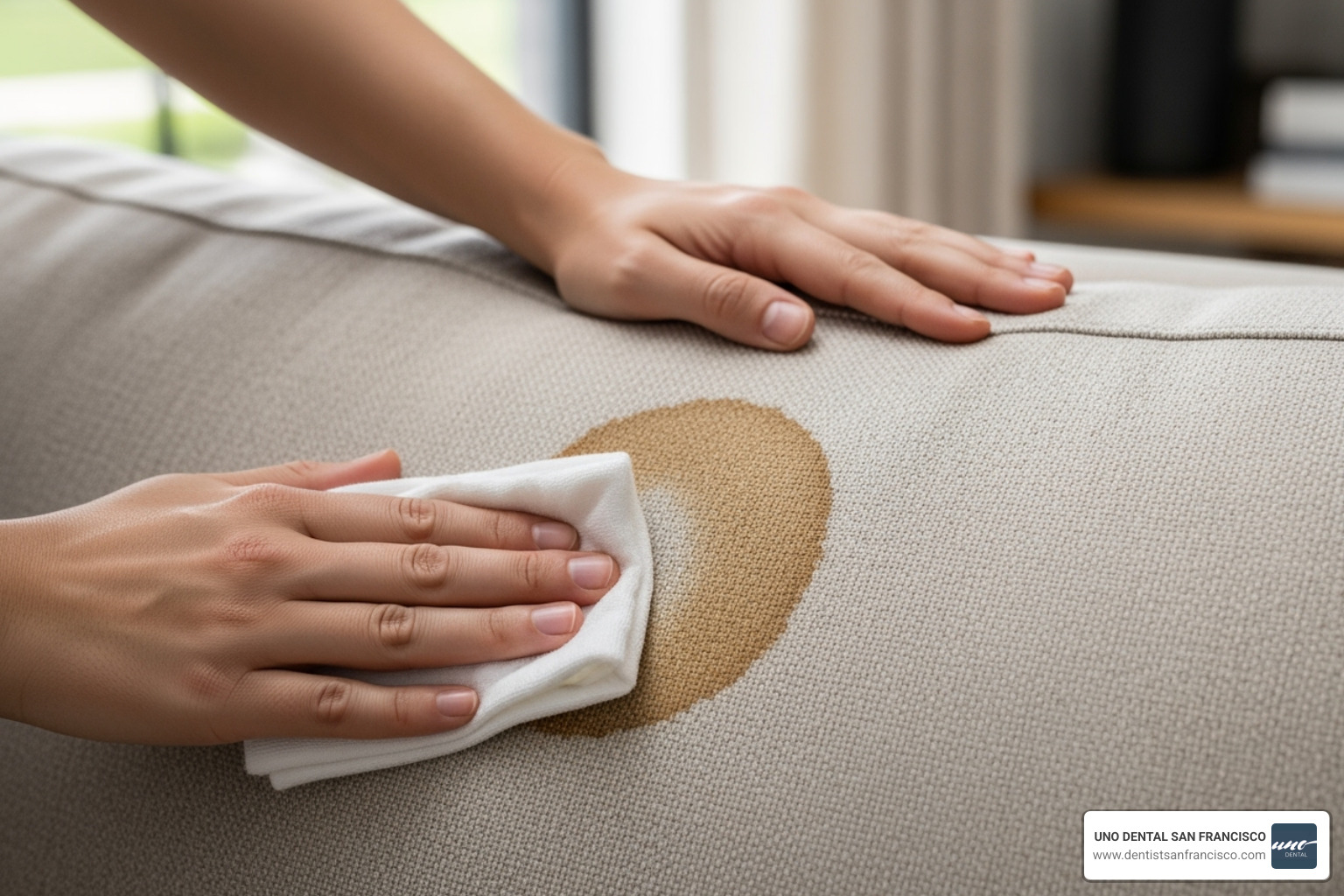
Why Coffee Stains Are More Common Than You Think
Coffee stain removal is a must-have skill for coffee lovers. With over half of Americans drinking coffee daily, spills are inevitable.
Quick Coffee Stain Removal Guide:
- Fresh stains: Blot immediately, rinse with cold water, apply liquid detergent
- Old stains: Soak in cold water for 30 minutes, create detergent paste, wash in hottest water safe for fabric
- Carpets: Blot excess, apply vinegar solution, rinse with clean water
- Wood surfaces: Wipe immediately, use mild soap solution, finish with wood polish
The science behind coffee's staining power lies in tannins—natural compounds that, combined with coffee's oils, bond quickly with fabrics and surfaces to create stubborn marks.
But here's the good news: coffee stains are easier to remove than you think. The key is using water and the right techniques to dilute and dissolve the brown tannins. Whether on your favorite shirt, carpet, or even your teeth, the right approach can restore surfaces. Most coffee stains can be eliminated with household items and proper technique.
As Mohammad Aghiad Kandar DDS at UNO DENTAL SAN FRANCISCO, I've seen how coffee stain removal extends beyond fabrics to oral health, as tannins also affect tooth enamel. My 15+ years of dental experience show that understanding stain chemistry helps patients maintain both their clothing and their bright smiles.
The Ultimate Guide to Coffee Stain Removal from Fabrics
You're rushing out the door, coffee in hand, when—splash!—it's all over your shirt. We've all been there. When it comes to coffee stain removal from fabrics, timing is everything.
When coffee hits fabric, its tannins start bonding with the fibers. The sooner you act, the easier the stain is to remove.
Your first instinct might be to rub the stain, but hold on! Blot, don't rub. Rubbing pushes the stain deeper into the fabric. Instead, grab a clean cloth or paper towel and gently blot from the outside of the stain inward.
Water temperature plays a crucial role. Cold water is your initial go-to because hot water can set the stain. Save warm water for later in the cleaning process.
Pre-treatment is a crucial step. It loosens stubborn tannins, making the final wash much more effective.
Here's the golden rule: avoid the dryer until that stain is completely gone. The heat from a dryer will set the stain permanently, turning a temporary mishap into a permanent one.
How to Remove Fresh Coffee Stains from Different Fabrics
Fresh coffee stains are the easiest to tackle because the tannins haven't had time to set.
Start with a cold water rinse. Hold the stained fabric, stain-side down, under cold running water. This pushes the coffee out instead of deeper into the fabric. Let the water run for 10 to 15 minutes, or until it runs clear.
Next, apply a small amount of liquid detergent directly to the stain. Work it in gently with your fingers and let it sit for 5 minutes to break down the coffee compounds.
For stubborn fresh stains, try a vinegar and dish soap solution. Mix two cups of cool water with one tablespoon each of dish soap and white vinegar. The vinegar's acidity helps break down tannins while the dish soap tackles coffee oils.
The soaking method works wonders on fresh stains that won't budge. Create a solution of one quart warm water, a half-teaspoon of dish soap, and one tablespoon of white vinegar. Let the stained area soak for about 15 minutes.
Keep these essential household stain-fighting ingredients handy: white vinegar, baking soda, and dish soap.
Tackling Old or Set-in Coffee Stains on Clothing
Don't panic if you find an old coffee stain. They're stubborn, but not permanent, and just require more patience.
Soaking in cold water is your first move. Rehydrate the dried tannins by soaking the garment for at least 30 minutes. For very stubborn stains, you can use warm water after the initial cold soak.
Create a detergent paste for concentrated cleaning. Mix powdered laundry detergent with a little water to form a paste. Work it into the stain with an old toothbrush, let it sit for a few minutes, then rinse.
Use an enzyme-based cleaner if your coffee had milk or cream. These cleaners contain enzymes that break down the proteins and fats in dairy.
For tough, colorfast cotton, try the hot water pouring method. Stretch the fabric over a bowl and pour near-boiling water from about 12 inches high onto the stain. The force flushes out deep-set tannins. Skip this for delicate fabrics or those that can't handle high heat.
After treatment, wash in the warmest water that's safe for your fabric. Always check the results before drying—if a shadow of the stain remains, repeat the process.
Specific Techniques for Synthetic vs. Natural Fibers
Different fabrics require different coffee stain removal approaches.
Natural fibers like cotton and linen are very absorbent, so stains can set quickly. The vinegar and dish soap treatment works well here. For white cotton, you can use the hot water pouring method as a last resort, but always test a hidden area first.
Synthetic fabrics like polyester and nylon are often more forgiving. After blotting and a cold rinse, a warm water solution with dish soap and vinegar usually works. If discoloration remains, try blotting with rubbing alcohol.
Delicate fabrics like wool and silk need a gentle touch. Skip harsh chemicals and hot water. Instead, mix a mild detergent with cool water and gently dab the stain with a clean white cloth. For these precious items, consult a professional cleaner when home methods aren't working or for expensive pieces.
Cleaning Coffee Spills from Carpets, Upholstery, and Hard Surfaces
Spilling coffee on your carpet or sofa is frustrating, but coffee stain removal from these surfaces is manageable. As dental professionals who deal with stains daily, we know the right approach.
Before using any cleaning solution, always perform a spot test in a hidden area. This simple step prevents a small stain from becoming a bigger problem by checking for discoloration or damage.
When tackling larger surface stains, work from the outside-in. This technique prevents the stain from spreading and helps you lift the coffee instead of pushing it deeper.
Recommended Steps for Carpets and Upholstery
When coffee hits your carpet or upholstery, act fast. Blot the excess coffee immediately with a clean, dry paper towel or white cloth. Press firmly to absorb as much liquid as possible, but don't rub—this can damage fibers and spread the stain.
For your cleaning solution, fresh stains respond well to a mix of two cups cool water and one tablespoon of dish soap. For dried or stubborn spills, add a tablespoon of white vinegar to the mix to help break down coffee tannins.
Apply your cleaning solution with a clean white cloth, gently dabbing the stained area. Work from the outside edges toward the center, continuing to blot until the stain lifts. For carpets, work the solution into the pile without oversaturating the area.
Once the stain is gone, rinse the area thoroughly with a cloth dampened with plain cold water. This removes any cleaning solution that might attract dirt later. Blot the area dry with a fresh towel, then let it air dry completely. A fan can speed up the process.
For lingering stains or odors, baking soda is your secret weapon. Sprinkle it generously over the completely dried area and let it sit for several hours or overnight. The baking soda absorbs moisture and odors. Simply vacuum it up the next day.
How to Safely Remove Coffee Stains from Wooden Surfaces
Wood surfaces require quick, gentle treatment. Coffee can penetrate wood finishes quickly, so immediate action is crucial. Wipe up spills as soon as they happen with a soft, clean cloth.
If a stain remains, use a mild soap and water solution. Dip your cloth in the foam on top, not the water, to avoid oversaturating the wood. Gently wipe the stain, rinse with a damp cloth, and dry immediately.
For set-in stains, a baking soda paste can work. Mix baking soda with water to create a thick consistency and apply it to the stain. Gently rub with a soft cloth, following the wood grain. Wipe clean with a damp cloth and dry thoroughly.
After any cleaning, restore your wood's protective finish with your usual wood polish or furniture oil. This protects it from future stains.
Erasing Stains from Coffee Mugs
Those brown rings in your coffee mug are tannins bonded to the ceramic. The good news is that coffee stain removal from mugs is simple.
The baking soda paste method is a great approach. Mix baking soda and water into a paste and scrub the inside of the mug with a sponge. The mild abrasive lifts stains without scratching. Rinse thoroughly for amazing results.
For a natural approach, try the salt and lemon technique. Sprinkle salt inside the mug and use half a lemon to scrub the stains. The lemon's acidity and salt's abrasive texture break down coffee residue, leaving a fresh scent.
Gentle scrubbing works best for stubborn, built-up stains. Persistent but careful scrubbing can restore even the most stained mugs to their original brightness.
The easiest prevention is to rinse your mugs immediately after use and wash them promptly. This simple habit prevents most stains from forming.
Beyond the Fabric: Removing Coffee Stains from Your Teeth
While we treat coffee spills on our shirts, we often ignore the same staining process in our mouths. The tannins in coffee that stain fabric also stain tooth enamel.
With every sip, these natural compounds attach to the microscopic pores on your teeth's surface, creating a dull, yellowish discoloration over time that regular brushing can't fix.
Coffee is also acidic, which gradually weakens tooth enamel, making it more porous and vulnerable to stains. This is why good oral hygiene is crucial for coffee lovers—not just to prevent cavities, but to protect your smile's brightness.
At UNO DENTAL SAN FRANCISCO, we see this challenge daily. Coffee is woven into San Francisco's culture, and we know giving up coffee isn't realistic. Instead, we focus on helping our patients enjoy their coffee while maintaining a confident, bright smile.
Professional Teeth Whitening for Coffee Stains
While many over-the-counter whitening products are available, they often struggle against years of coffee enjoyment. These products contain weaker whitening agents than what we use professionally, which can lead to minimal or frustrating results.
Professional teeth whitening treatments offer a different experience. When you choose professional teeth whitening at our practice, we use pharmaceutical-grade whitening agents that penetrate deep into your enamel to lift settled coffee stains.
The change can be dramatic, with many patients seeing their teeth become several shades whiter in just one appointment. We carefully monitor the process, personalizing the treatment for better results and less sensitivity than you'd experience with generic, one-size-fits-all products.
What makes professional treatment worthwhile is how long the results last. With proper care, your investment can keep your smile bright for years. We provide detailed guidance on Teeth Whitening for Coffee Stains to help you understand what to expect.
At-Home and Preventative Dental Care
Professional whitening is just the beginning. The real magic happens with your daily habits and the at-home maintenance tools we provide.
Our Custom Fit Teeth Whitening Trays are game-changers for maintaining your results. Unlike uncomfortable, one-size-fits-all trays, ours are molded specifically to your teeth. This ensures the whitening gel reaches every surface evenly for consistent results without irritating your gums.
Following your treatment, Teeth Whitening Aftercare is crucial for protecting your investment. We provide a comprehensive, manageable plan that fits your lifestyle.
A simple, effective habit: rinse with water immediately after drinking coffee. A quick swish washes away many tannins before they can settle.
Regular brushing remains your first line of defense. We recommend using a soft-bristled toothbrush with fluoride toothpaste, focusing on gentle circular motions rather than aggressive scrubbing that can damage enamel.
Our At Home Dental Whitening Guide walks you through everything you need to know to maintain your bright smile between professional treatments.
Combining professional treatment with smart daily habits means you don't have to choose between your love of coffee and a bright smile. With the right approach, you can enjoy both.
Advanced Coffee Stain Questions Answered
We know coffee stain removal can feel like a mystery. After years of helping patients understand how coffee affects their teeth and daily lives, I've gathered answers to the most common questions about tackling these stubborn stains.
How does milk or cream affect the coffee stain removal process?
When you spill coffee with milk or cream, you're dealing with a combination stain, which is more challenging than plain black coffee.
Adding milk or cream introduces proteins and fats alongside the tannins. This creates a complex stain with multiple agents working together.
This tannin, protein, and fat combination creates a tenacious bond with fabric. The proteins can weave into the fabric structure, while the fats leave a greasy residue that water alone can't remove.
Enzyme-based detergents are essential for these stains. These specialized cleaners contain catalysts that break down proteins and fats. Look for detergent labels that specifically mention enzymes.
Crucially, always use cool water for protein stains. Hot water can "cook" the milk proteins, setting the stain permanently. The University of Illinois Extension provides excellent detailed guidance on handling these combination stains.
What is the role of water temperature in coffee stain removal?
Water temperature is critical in coffee stain removal, and using the wrong temperature can set a stain permanently.
Cold water first is the golden rule for fresh coffee stains. It prevents tannins from setting deeper into the fabric, giving you time to treat the stain properly.
If your coffee contained milk or cream, cold water is even more important, as hot water will cook the proteins and set the stain.
After the initial cold-water rinse and pre-treatment, you can use warm or hot water for laundering. The higher temperature helps the detergent clean the fabric thoroughly and remove any remaining traces of the stain.
However, exercise caution with hot water on certain dyes and delicate fabrics. Some colors may bleed, and materials like silk or wool can be damaged. Always check your care label or stick with cooler water if in doubt.
What are the best practices for preventing coffee stains?
The best stain is one that never happens. A few simple prevention strategies can save you hours of frustration.
Use travel mugs with secure lids, especially when on the go. A quality, spill-proof design can prevent many accidents.
Use coasters on furniture to protect wooden surfaces from coffee rings. It's a simple habit that saves your furniture's finish.
Keep a stain pen handy for emergencies. Immediate spot treatment is crucial for preventing stains from setting. Keep one in your bag, car, or desk.
Rinse immediately after spills, whether on your mug or clothing. A quick splash of cold water can make the difference between easy removal and a stubborn stain.
Finally, practice mindful sipping. Being aware of your coffee cup's location can prevent many spills before they happen.
Conclusion
From a spill on your favorite shirt to mastering coffee stain removal from everything in your home, you're now armed with the knowledge to tackle any coffee catastrophe.
Effective stain removal comes down to a few principles: act fast, blot instead of rub, and choose the right solution for the material. With the right approach and some patience, nearly every coffee stain can be conquered.
The connection between a clean home and a radiant smile is deeper than you might think. The same tannins that stain your clothes also work silently on your teeth. Your smile deserves the same level of effective care.
At UNO DENTAL SAN FRANCISCO, we understand that coffee is more than just a beverage – it's a daily ritual, a moment of comfort, and for many San Franciscans, an essential part of life. That's why we've made it our mission to help coffee lovers maintain bright, healthy smiles without giving up their beloved brew.
When it comes to coffee stain removal from your teeth, the stakes are higher. Your smile is crucial for your confidence. While home remedies work on shirts, professional dental care ensures the safest, most effective, and longest-lasting results for your teeth.
Ready to restore that brilliant smile that's been hiding behind years of coffee enjoyment? We invite you to find the transformative power of professional teeth whitening. Explore our advanced teeth whitening services to restore your bright smile and let us help you achieve the confident, radiant smile you truly deserve.
Your coffee doesn't have to be the enemy of your smile – with the right care, you can enjoy both!



